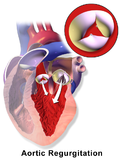Aortic valve repair
Aortic Valve Repair
Aortic valve repair is a surgical procedure aimed at correcting dysfunctions of the aortic valve, which is one of the four main valves in the heart. This procedure is typically performed to treat conditions such as aortic regurgitation or aortic stenosis, where the valve does not function properly, leading to compromised blood flow from the heart to the rest of the body.
Indications
Aortic valve repair is indicated in patients with:
- Aortic regurgitation: A condition where the aortic valve does not close properly, causing blood to flow backward into the left ventricle.
- Aortic stenosis: A narrowing of the aortic valve opening, which restricts blood flow from the left ventricle to the aorta.
- Congenital heart defects: Such as a bicuspid aortic valve, where the valve has only two leaflets instead of the normal three.
Surgical Techniques
Aortic valve repair can be performed using various techniques, depending on the underlying pathology:
- Leaflet repair: Involves reshaping or trimming the valve leaflets to ensure proper closure.
- Annuloplasty: A ring-like device is used to reshape or reinforce the valve annulus, the ring-like structure that supports the valve leaflets.
- Commissurotomy: Used primarily for aortic stenosis, this technique involves cutting the fused commissures to widen the valve opening.
- Decalcification: Removal of calcium deposits from the valve leaflets to improve their flexibility and function.
Advantages and Disadvantages
Aortic valve repair offers several advantages over aortic valve replacement:
- Preservation of native valve: Retaining the patient's own valve can lead to better long-term outcomes and fewer complications.
- Avoidance of anticoagulation therapy: Unlike mechanical valve replacements, repaired valves typically do not require lifelong anticoagulation therapy.
- Reduced risk of infection: There is a lower risk of endocarditis compared to prosthetic valves.
However, aortic valve repair may not be suitable for all patients, particularly those with severely damaged or calcified valves.
Postoperative Care
After aortic valve repair, patients typically require close monitoring in a cardiac intensive care unit. Postoperative care includes:
- Monitoring for complications: Such as bleeding, infection, or arrhythmias.
- Echocardiography: To assess valve function and ensure successful repair.
- Rehabilitation: Cardiac rehabilitation programs to aid recovery and improve cardiovascular health.
Prognosis
The prognosis after aortic valve repair is generally favorable, with many patients experiencing significant improvement in symptoms and quality of life. Long-term outcomes depend on the underlying condition, the success of the repair, and the presence of any comorbidities.
Related Pages
Transform your life with W8MD's budget GLP-1 injections from $125.
W8MD offers a medical weight loss program to lose weight in Philadelphia. Our physician-supervised medical weight loss provides:
- Most insurances accepted or discounted self-pay rates. We will obtain insurance prior authorizations if needed.
- Generic GLP1 weight loss injections from $125 for the starting dose.
- Also offer prescription weight loss medications including Phentermine, Qsymia, Diethylpropion, Contrave etc.
NYC weight loss doctor appointments
Start your NYC weight loss journey today at our NYC medical weight loss and Philadelphia medical weight loss clinics.
- Call 718-946-5500 to lose weight in NYC or for medical weight loss in Philadelphia 215-676-2334.
- Tags:NYC medical weight loss, Philadelphia lose weight Zepbound NYC, Budget GLP1 weight loss injections, Wegovy Philadelphia, Wegovy NYC, Philadelphia medical weight loss, Brookly weight loss and Wegovy NYC
|
WikiMD's Wellness Encyclopedia |
| Let Food Be Thy Medicine Medicine Thy Food - Hippocrates |
Medical Disclaimer: WikiMD is not a substitute for professional medical advice. The information on WikiMD is provided as an information resource only, may be incorrect, outdated or misleading, and is not to be used or relied on for any diagnostic or treatment purposes. Please consult your health care provider before making any healthcare decisions or for guidance about a specific medical condition. WikiMD expressly disclaims responsibility, and shall have no liability, for any damages, loss, injury, or liability whatsoever suffered as a result of your reliance on the information contained in this site. By visiting this site you agree to the foregoing terms and conditions, which may from time to time be changed or supplemented by WikiMD. If you do not agree to the foregoing terms and conditions, you should not enter or use this site. See full disclaimer.
Credits:Most images are courtesy of Wikimedia commons, and templates, categories Wikipedia, licensed under CC BY SA or similar.
Translate this page: - East Asian
中文,
日本,
한국어,
South Asian
हिन्दी,
தமிழ்,
తెలుగు,
Urdu,
ಕನ್ನಡ,
Southeast Asian
Indonesian,
Vietnamese,
Thai,
မြန်မာဘာသာ,
বাংলা
European
español,
Deutsch,
français,
Greek,
português do Brasil,
polski,
română,
русский,
Nederlands,
norsk,
svenska,
suomi,
Italian
Middle Eastern & African
عربى,
Turkish,
Persian,
Hebrew,
Afrikaans,
isiZulu,
Kiswahili,
Other
Bulgarian,
Hungarian,
Czech,
Swedish,
മലയാളം,
मराठी,
ਪੰਜਾਬੀ,
ગુજરાતી,
Portuguese,
Ukrainian
Contributors: Prab R. Tumpati, MD



